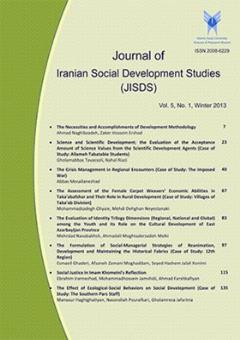Examining the Relationship between Media Consumption and the Citizens´ Real and Ideal Well-beings
Subject Areas : Journal of Iranian Social Development StudiesKobra shahrisvand 1 , محمدحسین اسدی 2 , Omid Ali Ahmadi 3 , Ali Roshanaie 4
1 - Ph. D student, Economic and Development Sociology, Faculty of Humanities, Ashtian Branch, Islamic Azad University, Ashtian, Iran
2 - Assistant Professor of Sociology Department, Faculty of Humanities, Ashtian Branch, Islamic Azad University, Ashtian, Iran
3 - Assistant Professor of Sociology Department, Faculty of Humanities, Ashtian Branch, Islamic Azad University, Ashtian, Iran
4 - Assistant Professor of Sociology Department, Faculty of Humanities, Ashtian Branch, Islamic Azad University, Ashtian, Iran
Keywords: social well-being, media consumption, real well-being, ideal well-being,
Abstract :
The present research’s main purpose is to examine the relationship between media consumption and real and ideal well-beings. The theoretical framework of the research is a combined theory from several perspectives, including Thompson's theory of self and experience in the media world and the theory of Bourdieu, Giddens, and Karl Mannheim. The research was conducted by survey method using the researcher-made questionnaire based on a structured sampling plan among Azna rural and urban citizens. The research sampling plan was a combination of cluster sampling and disproportionate classification; and, the sample size was estimated to be 392 individuals based on Cochran's formula, but considering sample drop, 400 people were selected and the questionnaire was distributed among them. The results showed that among the elements of well-being (economy and livelihood, health and treatment, job and employment, education, individual freedoms, political rights, security, media and communications, entertainment) in the real welfare variable, the highest average is assigned to the health and medical elements and the lowest to the security, media and communication elements; and, regarding ideal welfare, the highest average is assigned to the economy and livelihood elements, and the lowest to the security, media and communication elements. Also, the results showed a significant relationship between the three variables of media consumption, ideal well-being and actual well-being. The results of the univariate regression test showed the impact of real well-being and media consumption on the ideal well-being. Finally, the regression analysis results showed that 37% of the changes in Azna citizens´ ideal well-being can be explained through the variables of media consumption and real well-being.
1. باری، نورمن (1380) رفاه اجتماعی، ترجمه سیداکبر میرحسینی و سید مرتضی نوربخش ، تهران: انتشارات سمت.
2. پرویزیان، فرشاد، عرفانی، علیرضا، و ابونوری، اسمعیل (1398). نقش رسانه در شکل گیری انتظارات اقتصادی پویا و مدیریت سبد دارایی ها. مدلسازی اقتصادسنجی, 5(1 (پیاپی 16) ): 11-36.
3. تامپسون، جان (1389). رسانهها و مدرنیته، نظریه ي اجتماعی رسانهها، ترجمه ي مسعود اوحدي، چاپ دوم، تهران: نشر سروش.
4. جغتايي، محمدتقي(1379) سومين همايش جايگاه روستا در فرايند رفاه اجتماعي، دانشگاه علوم بهزيستي و توانبخشي، تهران.
5. جلایی پور، حمیدرضا؛ محمدی، جمال( 1388) نظریه های متخر جامعه شناسی، تهران: نشر نی.
6. دهشیری، محمدرضا(1388). "رسانه و فرهنگ سازی"، فصلنامه تحقیقات فرهنگی، دوره دوم، شماره 8 ، 179-208.
7. ریتزر، جورج (1383). نظريه جامعه شناسي در دوران معاصر، ترجمه محسن ثلاثي، تهران: انتشارات علمي.
8. ساروخانی، باقر (1383) اقناع، غایت ارتباطات، نامه علوم اجتماعی، 1(23 ): 93-115.
9. سورین، ورنر، جی، تانکارد، جیمز، دبلیو (1388) نظریههای ارتباطات، ترجمه علیرضا دهقان، تهران، موسسه انتشارات دانشگاه تهران.
10. شايگان، فريبا(1389) نگرش نسبت به رفاه اجتماعي- اقتصادي و رابطه آن با اعتماد سياسي در شهر تهران، برنامه ريزي رفاه و توسعه اجتماعي، دوره2 ، شماره3 ؛ 145 - 178 .
11. طباطبایی، محمدحسین،(1422 ق) نهایه الحکمه، قم: نشر اسلامی.
12. فراستخواه، مقصود (1393) اصالت با آرمان است یا واقعیت؟ صد ا،شماره21، چهارم بهمن 93، ص 46
13. فرقانی، محمد مهدی(1382). جامعه اطلاعاتی جهانی، گذر از الگوی حاکم، رسانه، شماره 55، 14-24.
14. فیتز پتریک، تنی (۱۳۸۱). نظریه رفاه، (ترجمه هرمز همایون پور)، تهران، نشر گام نور.
15. کازنو، ژان(1373). جامعهشناسی وسایل ارتباط جمعی، ترجمه منوچهر محسنی و باقر ساروخانی، تهران: اطلاعات.
16. گیدنز، آنتونی (1384). پیامدهایمدرنیت، ترجمه محسن ثلاثی، تهران: نشر مرکز.
17. لیالی، محمد علی(1392) از وضع موجود تا وضع مطلوب، مجله پرسمان شهریور و مهر ماه 1392 شماره 128-129 .
18. محكي ، علی اصغر(1382) «فن آوری های نوین ارتباطی و امنیت اخلاقی مطالعات امنیت ملی»، فصلنامه علمیکاربردی معاونت اجتماعی ناجا ، پیش شماره 2.
منابع
1. Bannet, F., 2004, Development of social Security, Social Policy Review, University of Bristol, Grear Britain: The Policy Press.
2. Brehm, J.M., 2003, Amenity Migration and Social Change: Expanding the Concept of Community Attachment and its Relationship to Dimensions of Well-being in the Rural West, Doctoral dissertation, Utah State University, Department of Sociology.
3. Diener E.(2013) The remarkable changes in the science of subjective well-being. Perspectives on Psychological Science. 8(6):663-6.
4. Dolan P, Peasgood T, White M.(2008). Do we really know what makes us happy? A review of the economic literatureon the factors associated with subjective well-being. Journal of economic psychology; 29(1):94-122.
5. Easterlin RA (2013). Happiness, growth, and public policy. Economic Inquiry. 51(1):1-5.
6. Fitzpatrick, T. (2001). Welfare Theory: an introduction. Basingstoke: Palgrave Macmillan.
7. Gainer, M. (2013). Assessing Happiness Inequality in the Welfare State: Self-Reported Happiness and the Rawlsian Difference Principle. Soc Indic Res. Vol. 114, Issue 2, 453-464.
8. Giddens, A., 2006, Sociology, Fifth Edition, Cambridge, Polity Press.
9. Thompson, J.B (1995).Media and Modernity. In Crowley and Mitchell (eds), Communication Theory Today, 27-49.
10. Wilkinson R, Kater P.1991,Income Inequality and population health: A reviw and explanation of the evidence. Social Sience & Medicine, 62, pp 1768-1784.


